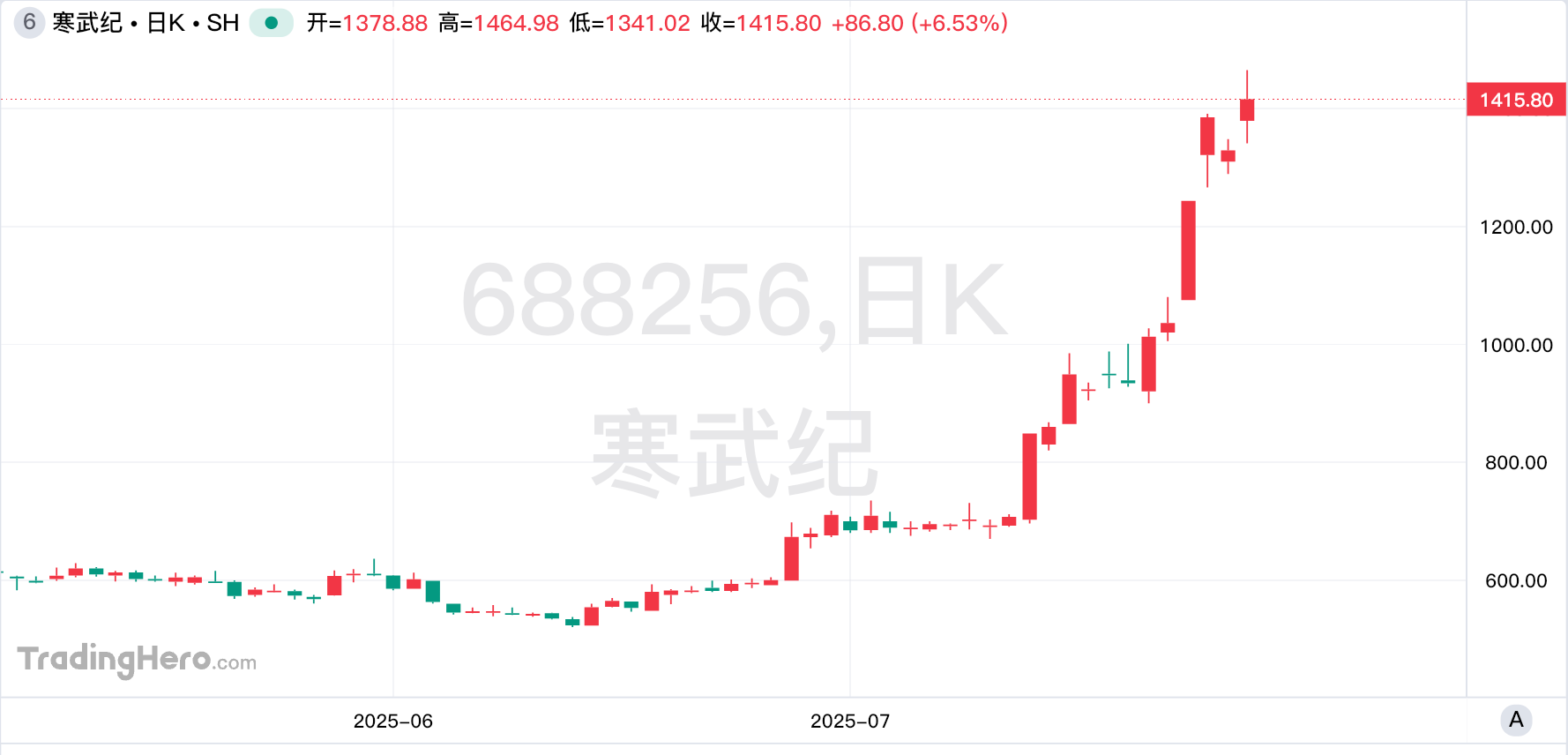Cambricon's stock price surpasses Moutai, claiming the title of "King of Stocks" in the A-share market
Cambricon's stock price continues to soar after the company delivered its best performance since going public. The impressive results have been favored by top individual investors and Wall Street investment banks.
At midday on Wednesday, Cambrian in the A-share market surged again, with its stock price once surpassing Kweichow Moutai, rising nearly 10% and reaching a peak close to 1,465 yuan per share.

Previously, the company's semi-annual report showed that the company has reached a historic turning point, delivering its best "report card" since its IPO, completing a remarkable turnaround from heavy losses to significant profits. Benefiting from the explosion of domestic AI demand in the "post-DeepSeek era" and strong policy support for domestically controlled chips, the company achieved a net profit attributable to shareholders of 1.03 billions yuan in the first half of the year, compared to a loss of 533 millions yuan in the same period last year; revenue soared approximately 43 times year-on-year to 2.9 billions yuan, marking its best performance since going public.
Behind the impressive results is the fact that domestic internet giants and startups are accelerating the adoption of domestic AI chips, replacing overseas products such as Nvidia. Regulators, out of security and supply chain risk considerations, require institutions to prioritize domestic solutions, which has comprehensively boosted market sentiment and driven the entire chip sector higher. Recently, against the backdrop of geopolitical frictions and supply uncertainties, Cambrian's market value doubled in a single month to over 600 billions yuan, making it the most outstanding A-share performer of the year.
Institutional opinions believe that as policies reiterate support for the development of industries such as artificial intelligence, smart vehicles, and robotics, the strategic importance of AI computing chips is becoming increasingly prominent.
Multiple favorable factors have attracted the attention of investors and Wall Street investment banks. Data shows that super investor Zhang Jianping bought Cambrian at the end of 2024 and became one of the top ten shareholders, holding 5.3388 million shares; in the first quarter of this year, he further increased his holdings by 747,500 shares.
Based on the stock price on August 26, Zhang Jianping's holdings are already worth as much as 8.089 billions yuan. If the average purchase cost is calculated based on Cambrian's average stock price in the fourth quarter of last year and the first quarter of this year, Zhang Jianping's purchase cost is about 3.046 billions yuan. If Zhang Jianping has not sold Cambrian shares since building his position, his maximum unrealized profit so far has reached 5.043 billions yuan.
With Cambrian's stock price soaring, Goldman Sachs announced an upward revision of its target price to 1,835 yuan. If the target price is reached, Cambrian's market value will approach 770 billions yuan. After surpassing Moutai's stock price on August 27, its market value is also expected to surpass many well-known companies such as Bank of Communications, Yangtze Power, Sinopec, and Postal Savings Bank of China.
According to statistics, there have previously been quite a few companies whose stock prices briefly surpassed Moutai, such as China Shipbuilding, Alltune Education, Hepalink, Amass Information, Baofeng Technology, Stone Technology, etc., but later their stock prices suffered sharp declines and even fell into difficulties. This is also commonly referred to in the market as the "Moutai Curse."
It should also be noted that although the company's profitability has improved significantly, industry competition is still intensifying. Currently, Nvidia still maintains an absolute lead, and the US government has recently allowed Nvidia and AMD to resume some chip sales to China.
To further consolidate its advantages, Cambrian has increased its support for large models such as DeepSeek, Alibaba's "Tongyi Qianwen," and Tencent's "Hunyuan," and announced a private placement of 4 billions yuan in July for the construction of a large model chip platform.
Disclaimer: The content of this article solely reflects the author's opinion and does not represent the platform in any capacity. This article is not intended to serve as a reference for making investment decisions.
You may also like
Zcash Faces Vitalik Buterin’s Challenge: What Lies Ahead?
In Brief Vitalik Buterin warns Zcash against token-based governance. Zcash community is divided over future governance approach. ZEC Coin struggles with market negativity and volatile price movements.

70M$ inflows this week: Bitcoin ETFs rise again

BlackRock Downplays IBIT Outflows as Bitcoin ETF Market Shows Signs of Recovery

